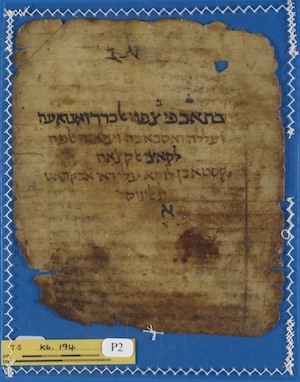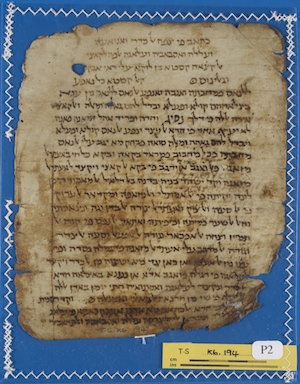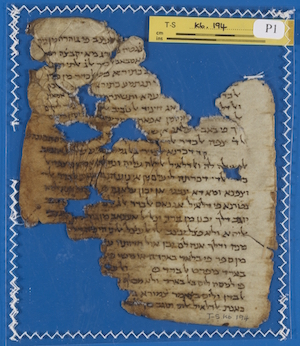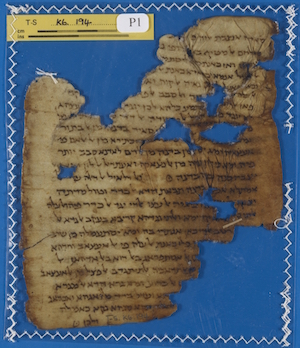The earliest known fragment of Qusṭā ibn Lūqā’s Book on Numbness: T-S K6.194
When in 1925, the poet W.B. Yeats published the results of his experimentations with automatic writing in his philosophical study A Vision: an Explanation of Life Founded upon the Writings of Giraldus and upon Certain Doctrines Attributed to Kusta Ben Luka, we might imagine that many of his readers struggled to identify the two characters referred to in the title.
While the identity of the first one, Giraldus, is still debated,1 the identification of the Yeatsian Kusta with the polymath Qusṭā ibn Lūqā al-Baʿalbaqī is more readily made.
From the information regarding the life and works of Qusṭā transmitted in the famous bio-bibliographical works by Ibn Juljul, Al-Nadīm, al-Qifṭī, Ibn Abī Uṣaybiʿa and Bar Hebraeus, we learn that Qusṭā, a Melkite Christian of Greek origin, was born around 820 CE in Baalbek (the ancient Heliopolis, a town in the Lebanese Beqaa Valley), and travelled extensively in his youth, collecting manuscripts of Greek scientific works.2 He was erudite in medicine, mathematics and musical theory, and his mastery of the Greek, Syriac and Arabic languages gained him the praise of more than one historian. After spending almost all his life in Baghdad, in his later years Qusṭā moved to Armenia, where he continued writing scientific works until his death. His written production falls into two categories: translations of scientific treatises and original works.
Qusṭā is responsible for various translations, among which the mathematical works of Diophantus, the Sphaerics and the De habitatione by Theodosius of Bithynia (which were translated into Latin by Gerard of Cremona in the 12th century), the Rising and Setting [of fixed stars] by Autolycus, the Mechanics by Hero of Alexandria, Galenic medical works and the list of Galen’s own books, and Aristotle’s Physics with the commentary by Alexander of Aphrodisia on books IV, V, and VII.
His original production dealt generally with the same fields: mathematics, geometry, astronomy, astronomical instruments, physics, and medicine. His original works are listed in Al-Nadīm’s Fihrist and were partially transmitted to the Latin West in influential Latin translations. This is, for instance, the case of his treatise On the Difference between the Spirit and the Soul, which in the 1250s was included in the natural science curriculum of the Faculty of Arts of Paris under the title De Differentia Spiritus et Animae.3
Given the extent and influence of Qusṭā ibn Lūqā’s original works and translations, it is not surprising that his name and production would appear among the numerous Genizah fragments preserving Judaeo-Arabic renditions of Arabic translations of Greek scientific works and Arabic original treatises in both Arabic and Judaeo-Arabic language.
One mention of ‛The chapters by Qusṭā ibn Lūqā on medicine’ is found in a list of books from the Mosseri collection (Mos. I.106), which was published by Mann and Allony.4 Moreover, the opening of another original work by Qusṭā, the Madḵal ilā ṣināʿat al-handasa, is found in a very elegantly written Arabic fragment on parchment, T-S Ar. 53.59, which I am planning to study in more detail.
An even more interesting discovery was made while I was describing the fragments preserved in the T-S K6 folders which largely contain colophons and the beginnings of books. Leafing through these folders, I was surprised to find two very old looking leaves of parchment, written in Judaeo-Arabic: T-S K6.194. The title-page of the work preserved on this fragment is easily readable: Kitāb fī ṣifa al-ḵadar wa-anwāʿihi wa-ʿilalihi wa-asbābihi wa-ʿilājihi allafahu li-qāḍī al-quḍāh Qusṭā ibn Lūqā ʿalā rāy Abuqrāṭ wa-Jālīnūs (Book on the description of numbness, its kinds, its causes, its reasons and its treatment, that Qusṭā ibn Lūqā composed for the Chief Judge according to the opinions of Hippocrates and Galen).
Cambridge University Library T-S K6.194 P2 verso
It is currently known that the Book on numbness has only survived in one complete manuscript, the Ayasofia 3724 (cc. 222 verso – 236 verso), in the Süleymaniye Kütüphanesi (Istambul). According to Sezgin, the date of the production of this copy is 721 H. (=1321/2 CE). An extensive study of the work was published in 2000 by Prof. Lena Ambjörn of Lund University, who prepared a diplomatic edition of the Ayasofia manuscript, an English translation and a detailed commentary and lexicon of the materia medica mentioned in the treatise.5
A closer analysis of the text by eyes better trained at paleography than my own,6 revealed a very interesting fact: the Judaeo-Arabic fragment predates the only known complete manuscript of this work by at least three centuries. Its paleographic features suggest a date between the late 10th and the 11th century, only about a century after the generally accepted date of death of Qusṭā ibn Lūqā (912 CE).
On the verso of the frontispiece page, the Book on the Description of Numbness opens with a dedicatory passage to the Chief Judge aimed at capturing his favour:7 the Qāḍī al-Quḍāh is the greatest benefactor of his time and therefore deserves to be loved and to be healthy. The Galenic theoretical frame of Qusṭā’s medicine is clearly stated right at the opening of the book: ‛[…] the preservation of every living being is the balancing of its mixture (bī-iʿtidāl mizājihi). It is necessary to desire the preservation of the judge and to aspire to keep the balance of his mixture’.
As a matter of fact, all seems to be fine with the Judge’s mixture. Qusṭā writes that, considering the status of the Judge’s shape and colour, his blood-vessels, the healthy look on his face and the quality of his hair together with his prime psychological features, all point to a balanced mixture of the whole body, in all its parts (iʿtidāl mizājihi fī jumla jasadihi wa-fī ʿaḍū min al-aʿḍāʿ). Nevertheless, the Judge complains about numbness of one of his feet, which prevents him from moving around properly. The aim of Qusṭā’s treatise is therefore to record in an orderly way what will serve to treat his ailment and to understand its causes.
Cambridge University Library T-S K6.194 P2 recto
The Genizah leaves of On Numbness are not continuous. A portion of the treatise including the table of contents of the book, the definition of numbness as a loss of the sense of touch due to a block in the normal flow of pneuma in the body and a discussion of the different causes that can lead to such a block are now lost. The second leaf of the fragment preserves the conclusion of chapter 3 and the opening of chapter 4. After describing numbness and its causes in detail, Qusṭā here moves on to considering the particular kind of numbness that affects the Judge and, through a close examination of his symptoms and his habits, he comes to the conclusion that the Judge’s ailment is determined by two concurrent causes: the fullness of the flesh that surrounds the faulty nerve and the accumulation of impurities in the nerve itself. The cure should include phlebotomy and the assumption of a hot purgative drug to relieve the affected nerve from its blockage. Nevertheless, we are informed that the judge loathes and fears blood extraction, and Qusṭā is determined to try and cure him with nothing but drugs.
Cambridge University Library T-S K6.194 P1 recto
Cambridge University Library T-S K6.194 P1 verso
A comparison between the Judaeo-Arabic text preserved in these two leaves and the edition of the Arabic codex unicum prepared by Prof. Ambjörn reveals the presence of a good number of textual variants. As far as the small portion of text preserved in the Judaeo-Arabic shows, these variants do not introduce significant changes to the general sense of the text, being mostly morphological or lexical variations. Some details of the Judaeo-Arabic version – e.g. the presence or absence of Arabic articles in some phrases or the choice of particular synonyms – make me inclined to consider the Judaeo-Arabic fragment as representative of a line of transmission more faithful to the archetype of the treatise in comparison to the later Arabic manuscript. Further investigation will be needed in order to confirm this hypothesis.8
The presence in the Genizah of these folios from a 10th/11th century Judaeo-Arabic copy of an Arabic medical book adds another piece of evidence to the lively picture of the circulation and study of Graeco-Arabic and Arabic sciences in the medieval Jewish communities of the Islamic world.
Footnotes
1 Scholars are still considering six possible identifications: i) Geraldus Cambrensis (Gerald of Wales, 1146–1223), chronicler and archdeacon of Brecon; ii) Geraldus Cremonensis (1114–1187), one of the most famous and prolific translators of Arabic scientific works into Latin, who was active in 12th-century Toledo; iii) Lilius Gregorius Gyraldus (Gilio Gregorio Giraldi, 1479–1552), an Italian poet and classicist, who also wrote important calendrical treatises; iv) Gerardus Dorneus (Gerhard Dorn, 1530–1584), a Belgian philosopher, translator and alchemist, student of Paracelsus, and responsible for the rescue and Latin translation of Paracelsian manuscripts; v) William Allingham (1824–1889), Irish poet and editor, who published the anthology Nightingale Valley under the pseudonym Giraldus; vi) the Giralda, the clocktower of Seville, which was originally built as a minaret. More details about these identifications can be found at http://www.yeatsvision.com/Kusta.html. For an extensive bibliography on Yeats’ Vision, see http://www.yeatsvision.com/Biblio.html#Critical.
2 See Ibn Ǧulğul, Ṭabaqāt al-Aṭibbāʾ wal-Ḥukamāʾ, ed. Fuʾād Sayyid (Publications de l’Institut Français d’Archéologie Orientale du Caire: Cairo 1995), 76; An-Nadīm, Kitāb al-Fihrist, ed. Flügel, (Leipzig 1871-2), 243:17-18; 244:19-20; 254:6-7; Ibn Al-Qifṭī, Taʾrīḵ al-Ḥukamāʾ, ed. Lippert (Leipzig 1903), 262 ff.; Ibn Abī Uṣaibiʿa, Kitāb ʿUyūn al-Anbāʾ fī ṭabaqāt al-aṭibbāʾ, ed. Müller (Kairo-Königsberg 1882-4), I:244 ff., II:166:15; Abū l-Farağ b al-ʿIbrī (Barhebraeus), Kitāb muḵtaṣar taʾrīḵ ad-duwal, ed. Ṣaliḥanī (Beirut 1890), 259:10-17.
3 A list of Qusṭā’s works can be found in Sezgin, Geschichte des arabischen Schrifttums, (Brill: Leiden 1967ff), III: 270 ff.; Ullmann, Die Medizin im Islam, (Brill: Leiden-Köln 1970), 126-128; Gabrieli, “Nota biobibliografica su Qusta ibn Luqa”, Rendiconti della Reale Accademia dei Lincei (Classe di scienze morali, storiche e filologiche), V, vol.21 (1912), 341-382.
4 Mann, J., Texts and Studies in Jewish History and Literature, (Hebrew Union College Press: Cincinnati 1931), 658-9. Allony, N., The Jewish Library in the Middle Ages. Book lists from the Cairo Genizah [Hebrew], (Ben-Zvi Institute – Hebrew University: Jerusalem 2006), 49-50.
5 Ambjörn, L., Qusṭā ibn Lūqā on Numbness. A Book on Numbness, its Kinds, Causes and Treatment according to the opinion of Galen and Hippocrates, (Almqvist & Wiksell International: Stockholm 2000).
6 I am very grateful to Prof. Judith Olszowy-Schlanger for her valuable advice on paleographic matters.
7 While the Judaeo-Arabic fragment does not preserve the name of the judge to whom this work is dedicated, the 14th-century Arabic manuscript reports his name as Abū Muḥammad al-Ḥasan ibn Muḥammad.
8 I am planning to undertake further work on the Genizah fragments that refer to Qusṭā ibn Lūqā and his works and to prepare an edition and translation of this fragment and of T-S Ar. 53.59.
My research on the medical fragments in the Cambridge Genizah Collections is supported by the Wellcome Trust Research Resources Award Medicine in medieval Egypt: creating online access to the medical corpus of the Cairo Genizah.

Ferrario, G. (2015). The earliest known fragment of Qusṭā ibn Lūqā’s Book on Numbness: T-S K6.194. [Genizah Research Unit, Fragment of the Month, September 2015]. https://doi.org/10.17863/CAM.8549
If you enjoyed this Fragment of the Month, you can find others here.
Contact us: genizah@lib.cam.ac.uk
The zoomable images are produced using Cloud Zoom, a jQueryimage zoom plugin:
Cloud Zoom, Copyright (c) 2010, R Cecco, www.professorcloud.com
Licensed under the MIT License




